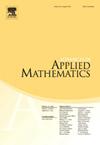k-loose elements and k-paving matroids
IF 1.3
3区 数学
Q3 MATHEMATICS, APPLIED
引用次数: 0
Abstract
For a matroid of rank r and a non-negative integer k, an element is called k-loose if every circuit containing it has size greater than . Zaslavsky and the author characterized all binary matroids with a 1-loose element. In this paper, we establish a sharp linear bound on the size of a binary matroid, in terms of its rank, that contains a k-loose element. A matroid is called k-paving if all its elements are k-loose. Rajpal showed that for a prime power q, the rank of a -matroid that is k-paving is bounded. We provide a bound on the rank of -matroids that are cosimple and have two k-loose elements. Consequently, we strengthen the result of Rajpal by providing a bound on the rank of -matroids that are k-paving. Additionally, we provide a bound on the size of binary matroids that are k-paving.
k-松散单元和k-铺装拟阵
对于秩为r且非负整数k的矩阵,如果包含该元素的每个电路的大小大于r - k,则该元素称为k-loose。Zaslavsky和作者刻画了所有具有1-松散元的二元拟阵。在本文中,我们建立了一个二元矩阵的大小的尖锐线性界,根据它的秩,其中包含一个k-松散元素。如果一个矩阵的所有元素都是k-松散的,那么它就被称为k-铺路矩阵。Rajpal证明了对于素数幂q,铺k的GF(q)-矩阵的秩是有界的。我们给出了具有两个k-松散元素的复单GF(q)-拟阵的秩界。因此,我们通过提供k铺砌的GF(q)-拟阵的秩界来加强Rajpal的结果。此外,我们还提供了k-铺装的二元拟阵的大小的一个界。
本文章由计算机程序翻译,如有差异,请以英文原文为准。
求助全文
约1分钟内获得全文
求助全文
来源期刊

Advances in Applied Mathematics
数学-应用数学
CiteScore
2.00
自引率
9.10%
发文量
88
审稿时长
85 days
期刊介绍:
Interdisciplinary in its coverage, Advances in Applied Mathematics is dedicated to the publication of original and survey articles on rigorous methods and results in applied mathematics. The journal features articles on discrete mathematics, discrete probability theory, theoretical statistics, mathematical biology and bioinformatics, applied commutative algebra and algebraic geometry, convexity theory, experimental mathematics, theoretical computer science, and other areas.
Emphasizing papers that represent a substantial mathematical advance in their field, the journal is an excellent source of current information for mathematicians, computer scientists, applied mathematicians, physicists, statisticians, and biologists. Over the past ten years, Advances in Applied Mathematics has published research papers written by many of the foremost mathematicians of our time.
 求助内容:
求助内容: 应助结果提醒方式:
应助结果提醒方式:


